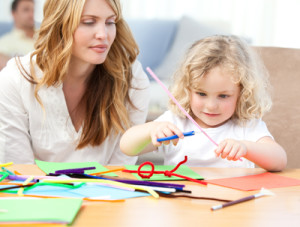 Bilateral coordination refers to the ability to coordinate both sides of the body at the same time in a controlled and organized manner; for example, stabilizing paper with one hand while writing/ cutting with the other. Good bilateral integration/ coordination is an indicator that both sides of the brain are communicating effectively and sharing information. Children who have difficulty coordinating both sides of their body can have difficulty completing daily living tasks (dressing, tying shoes), fine motor activities (banging blocks together, stringing beads, buttoning), visual motor tasks (drawing, writing, cutting, catching/ throwing), and gross motor activities (crawling, walking, climbing stairs, riding a bike).
Bilateral coordination refers to the ability to coordinate both sides of the body at the same time in a controlled and organized manner; for example, stabilizing paper with one hand while writing/ cutting with the other. Good bilateral integration/ coordination is an indicator that both sides of the brain are communicating effectively and sharing information. Children who have difficulty coordinating both sides of their body can have difficulty completing daily living tasks (dressing, tying shoes), fine motor activities (banging blocks together, stringing beads, buttoning), visual motor tasks (drawing, writing, cutting, catching/ throwing), and gross motor activities (crawling, walking, climbing stairs, riding a bike).
“Crossing the midline” is an integral skill related to bilateral coordination. Crossing the midline refers to the ability to spontaneously cross over the midline of the body during motor completion/ functional tasks- moving one hand, foot, or eye into the space of the other hand, foot, or eye (i.e. sitting with legs crossed, scratching the opposite elbow, successfully intersecting lines to draw a cross- without switching hands, reading left to right, etc.). Babies and toddlers may use both hands equally and initiate picking up or interacting with an object with whichever hand is closer (i.e. if the item is on the left side of the table he will likely use the left hand, if it the object is on the right side, he will likely use the right hand). However, by 3-4 yrs. of age a child should typically have mastered the skill of “crossing midline.” Establishing hand dominance (a “worker hand” vs. a “helper hand”) is an indicator that the brain is maturing and lateralization is occurring- this is strongly correlated with the ability to cross midline. The child who avoids midline crossing can have difficulty coordinating both sides of the body and often times, has difficulty establishing hand dominance; tends to alternate hand use when coloring, writing, eating, throwing, etc.
Another important foundation in the development of bilateral coordination is body awareness. Body awareness refers to the ability to know where your body is in space without necessarily using vision (i.e. how high to lift your leg when climbing stairs, etc.); it involves proprioception, which is feedback from muscle and joint sensations. Children who do not have adequate body awareness may appear a bit clumsy, be cautious with movement or fearful with feet off ground (tossing in air, swinging, etc.), seek (or avoid) deep input or be too rough with peers/ toys (wrestling, crashing, carrying/ pushing/ pulling heavy objects). Subsequently, children who do not have a good sense of where their body’s/ body parts’ are in space can present with difficulty coordinating both sides of their body to complete bilateral tasks (i.e. putting on socks and shoes, throwing/ catching a large ball with 2 hands).
The following activities are helpful suggestions for developing bilateral coordination:
- Bopping a balloon back and forth or popping bubbles with both hands
- Tearing/ crumpling tissue paper, cottonballs (create a craft, etc.)
- Connecting/ separating construction toys; magnetic blocks, Mega blocks, pop-beads, Legos
- Playing catch/ throw games to encourage coordinating both hands
- Playing with toy instruments; banging drums, triangle, symbols
- Pinching, pulling, squeezing, play-doh (finding hidden objects, etc.); as well as using the play-doh “tools”
- Playing with a Zoom Ball
- Stringing uncooked pasta on yarn or beads on pipecleaners/ string
- Snipping/ cutting with scissors- yarn, string licorice, play-doh, construction paper (thicker), coupons, etc.
- Lacing activities/ games- i.e. use hole punchers with craft projects and have the child lace string/ yarn through the holes
- Mr. Potato Head
- Frosting cookies with a butter knife, spreading peanut butter on crackers/ toast
(Activities for developing body awareness:)
- Playing the Hokey Pokey or “Simon Says:” have the child imitate body positions as well, “Simon Says do this…..” and include symmetric and asymmetric body poses
- Climbing on the playground: up the slide (both the ladder and the incline), up/ down stairs, on/ off equipment
- Obstacle courses
- Playing on dynamic (moving) equipment- small trampoline, balance board, swings
- Pushing/ pulling weighted objects; medicine balls, weighted carts, carrying grocery bags, laundry basket, taking out the trash, etc.
- Sports/ athletics: gymnastics, karate, yoga, wrestling, soccer, basketball, baseball, etc
- Playing Tug-of-War; and crashing into a pile of pillows, beanbags
- Swimming
- Wheelbarrow walking, animal walking (bear walk, crab walk, snake crawling)
- Playing “Twister”

